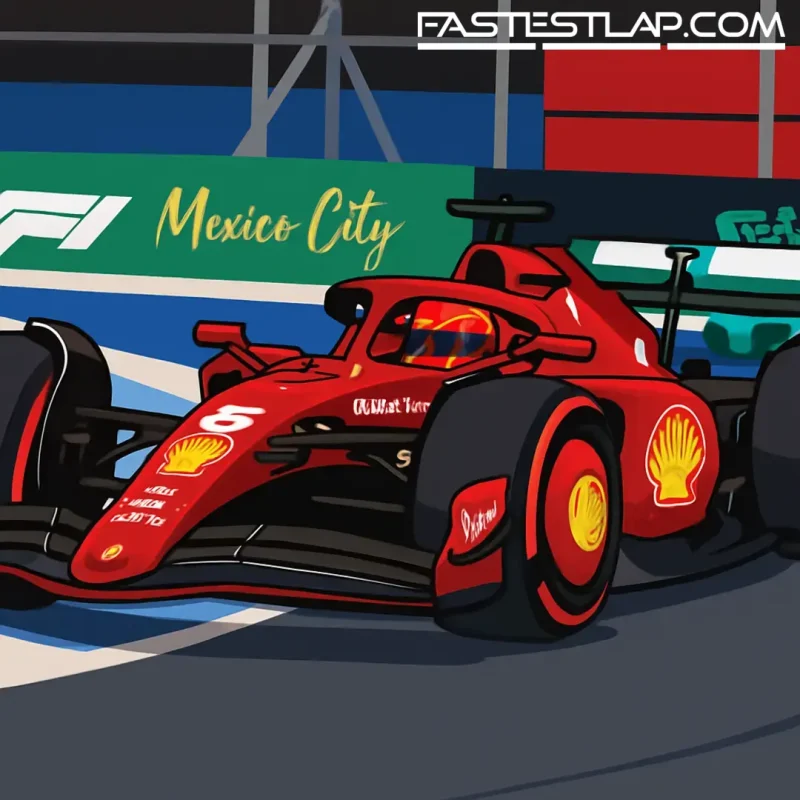Mexico City — The longest drag race in Formula 1 is back on the menu, and Charles Leclerc would rather line up third than first to face it.
Ferrari’s pole-sitter cut a wry smile after qualifying in Mexico City and admitted he’d happily swap with Lewis Hamilton on the grid. Not out of charity—out of physics. From pole, you’re a sitting duck on the 830-metre cannon-shot to Turn 1. From P3, you’re a torpedo with a tow.
“The run to Turn 1 is very long and we’ve got to do the best possible start,” Leclerc told F1TV. “I wish I was P3 for the start because at least you have a little bit of a slipstream. I probably won’t have any slipstream in front of me and I’m starting on the dirty side of the track. But I’ll focus on what I can control and try to do my best from where we start, which hopefully will be enough to take the lead into Turn 1.”
That’s the game here at the Autódromo Hermanos Rodríguez: pole is prestige, P3 is potential energy. Hamilton, who shares the second row, didn’t disagree. “It’s hard to beat these two guys today, but I mean P3 is kind of the perfect spot actually at this track,” the seven-time World Champion said. “I’m hoping I can make the most of that at the start.”
It doesn’t hurt that Hamilton’s Ferrari and Leclerc’s Ferrari punch a clean hole in the air for anyone close enough to cling on. If Leclerc nails the launch, dirty air could be his only protection—pulling the rug from under the front wings and tyre life of whoever’s chasing. If he doesn’t, Turn 1 gets very busy, very fast.
Hamilton’s optimism is tempered by the one thing Mexico never lets anyone forget: altitude. Engines gasp, brakes fry, tyres slide, and every cooling inlet on the grid earns its keep. “It’s tough with the altitude, with the overheating of the car, with the overheating of the brakes,” he said. “I’m pretty sure most people have that experience here with the lack of cooling. So it won’t necessarily be easy. But you’ve got some great drivers behind us. So we shall see.”
Some of those drivers are exactly the ones Leclerc would prefer not to see in his mirrors. Max Verstappen starts from fifth, and that’s more than close enough at this place. The Red Bull isn’t shy in a straight line, and Verstappen’s judgment into a three-wide Turn 1 is rarely tentative. McLaren’s Oscar Piastri starts eighth, but his long-run pace has been a quiet threat all season; if he taps into the kind of Sunday speed Lando Norris has often uncorked, the papaya charge can come from further back than you’d think.
“I’d rather be in my position than theirs,” Leclerc said of Verstappen and Piastri. “But yeah, they’ve got the pace. Especially if Oscar finds the pace that Lando had on the high fuel, I think he’ll probably have the pace to come back. But it’s obviously a lot more difficult.”
There’s another wrinkle: track polish. Pole at Mexico sits on the dirty side, and it’s a cruel place to be when you need traction and you’ve got 19 hungry cars keying off your getaway. If the lead Ferrari flinches, the draft turns carnivore. If it launches clean, Mexico’s other signature feature—high-downforce cars losing their cool in paper-thin air—becomes the defending champion. Get within a second, you cook. Fall out of it, you’re stuck in no-man’s land. The pace delta has to be real to pass without a misstep ahead.
That’s why Hamilton’s reading of P3 as “perfect” isn’t bravado. It’s geometry. You’re close enough to cash the slipstream, far enough to pick your line and avoid the sandwich into Turn 1. And if the Ferrari duo can keep it tidy through that first complex, they can try to play the long game—temperature management, tyre offsets, and timing the undercut in a pit lane where mistakes are expensive.
But this is Mexico. The Foro Sol will be shaking, the approach will feel like a runway, and the first 15 seconds will decide whether we get a controlled Ferrari duet or a free-for-all with Verstappen and the rest smelling blood.
Watch the launch lights. Watch the second row. And watch for the tow—because on this strip of asphalt, the grid is just a suggestion.




